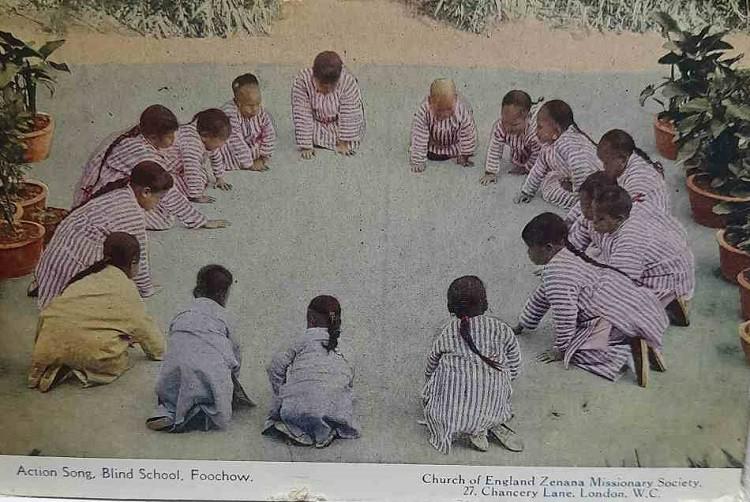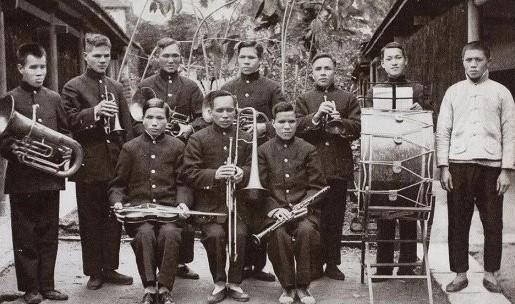The “Fuzhou School for the Blind” is a century-old school specializing in the education of the visually impaired (including low vision). It was founded in August 1898 (the 24th year of Emperor Guangxu’s reign) by Amy Oxle Wildinson, an Australian of British nationality, as the C.M.S. (Church Missionary Society) Blind Boys School in Fuzhou.
In 1896, Miss Amy Oxle Wildinson was sent by the Church of English to China to preach the gospel. She came to Lianjiang, Fuzhou, and worked as a nurse in a hospital. During her medical career, she came into contact with some blind children. Having compassion for them, she decided to serve them as her lifelong career. In 1898, Wildinson rented a house in Dongdai Village, Lianjiang County, to shelter blind children free of charge, and founded a school for the blind - the C.M.S. (Church Missionary Society) Blind Boys School. The earliest teaching method of the school was to learn from the teaching experience of Mr. Cook, a missionary in Shunchang County, Fujian Province. The Bible was used as the text, and raised dots were used to represent the initial and consonant sounds of Roman characters, which could be used to spell out the Fuzhou dialect. This dialect has more than 30 letters in Braille, and each syllable needs at least two dots.
The first blind child to attend the school was Xiao Lingkai, the son of a local widow. Six weeks after entering the school, he was able to read Braille and write the Gospel of Mark, and his grades were pretty good. Subsequently, six students joined, including a 4-year-old child with visual impairment and an old man in his late 70s. By 1900 (the twenty-sixth year of the reign of Emperor Guangxu of the Qing Dynasty), 17 visually impaired people had been admitted into the school. The students respectfully called Wildinson "Aunt". In 1900, due to the Boxer Rebellion, the Lianjiang School for the Blind was forced to close.
When Wildinson returned to Australia, she encouraged the local Anglican Church to support the education of blind children in China and actively raised funds. In 1901, she returned to Fuzhou and founded a school for the blind in Meiwu, Cangqian, then she moved to Hualinfang, North Gate, and finally onto Chaijingding, Fuzhou (present day site of Yuehua Hotel, of the Xihu Hotel chain). In 1903, Amy married Dr. G. Wilkinson, the president of the Chaijing Christian Hospital in Fuzhou (the predecessor of the Fuzhou First Hospital affiliated to Fujian Medical University), which was founded by the Anglican Church in 1898. Soon, the school purchased land opposite the Chaijing Christian Hospital in Fuzhou and moved the Cangqian Meiwu Blind School to that place. The school concept of “feeding the mouth with hands” was first proposed. That is, to allow the blind to feed themselves with their own hands.
In the beginning, the school had a kindergarten, junior and senior primary schools, and then added a craft department and a brass band. The school runs a part-time school system. The primary school curriculum included: Mandarin, abacus, singing, religion and so on; History, Geography, English, music, and composition were also offered in the senior primary school. The craft department had courses like knotting straw mats, weaving bamboo basket, making veranda chairs, making brown curtains, repairing organs, repairing piano, and other courses. In those days, Braille teaching in Fuzhou Lingguang Blind School was at the forefront of the country.
Around 1911, Ms. Amy improved Braille, increasing the number of letters to 53, tone symbols to 7, and each syllable was composed of 3 dots for sound, rhyme, and tone. Around 1920 (the ninth year of the Republic of China), she also put forward the word as a unit of abbreviation, and space was added before and after the abbreviated word, which is the predecessor of segmentation form of Chinese Braille word.
In 1910, Xiao Lingkai, the first student to enroll in the School for the Blind, led four other students to bring their woven bamboo baskets, straw mats, sweaters, and other handmade products to an industrial exhibition held in Nanjing and won gold medals and certificates from the Qing government. In 1915, at the first World’s Fair in Panama, the exquisite handicrafts of the blind children of Lingguang were honored. In the summer of 1929, the school moved into the Western-style school buildings in the medical school. The people in the technology department of the blind school invented the technology of tying mats with seaweed using a mat weaving machine. The mats could be dyed in various colors and sold well all over the country.
The brass band of Lingguang Blind Boys School was once famous all over the world. Amy formed the school’s brass band, or “military band,” which played Chinese and Western repertoire at school gatherings. In 1917, the band of Lingguang Blind Boys School began a two-year tour, which took them to Xiamen, Quanzhou, Shantou, and other places. In 1922, all 11 people of the blind child brass band accepted the invitation of the Anglican Church and began their tour of the three islands of Britain. They were warmly welcomed in each city, and even got received by the wife of the British King George V - Queen Mary. They performed Chinese and Western classics for the royal family. The British newspapers gave high praise. They originally planned to tour in the UK for only 3 months. However, unexpectedly, they were repeatedly urged to stay by the British people and also received by the Queen of England. This extended their journey to 22 months before they returned home. This is a fantastic story in the history of modern music and cultural exchanges between the East and the West and is also the honor of modern Fuzhou music history. Later, the brass band of Li Houji, the provincial military governor of Fujian, was guided by the people from the band of C.M.S. Blind Boys School.
In 1903, Stephen Emily, sent by the British Indian Women Church, arrived in Fuzhou and established the Private Fuzhou Mingdao Blind Girls School on Shipu Road, Cangshan, by renting a private house to teach blind girls. Most of its students were homeless blind girls and children displaced by natural disasters such as famine in Shanxi, Xiamen, and Singapore. In 1922, a red-brick school building was built, the Mingdao Blind Girls School in Shipu, which made greater progress in teaching. The teaching and manual curriculum of the school is similar to that of the C.M.S. Blind Boys School. The school was divided into kindergarten and primary school. The main subjects taught were: Braille (taking the Bible as the text to learn Braille in Fuzhou dialect), abacus, singing, learning semaphore, and playing the piano.
In 1928, the school for the blind began to teach Mandarin and Braille. By 1936, the courses offered were expanded to Mandarin, Civics, History, Geography, Nature Study, General Knowledge, English, and Religion. As the students were all visually impaired girls, knitting and weaving were offered as vocational courses. The courses were mainly about housekeeping, such as decorating the house, washing dishes, fetching water, washing clothes, sewing, babysitting, etc. According to 1928 statistics, there were more than 80 students in the Mingdao Blind Girls School, ranging from 3 years old to over 40 years old. Most of the adult students were unwilling to marry and were willing to stay on campus to teach or assist in missionary work. A church elder, Sister Cai Lixia, who is now over 80 years old, is a native of Gulangyu, Xiamen. She has been blind since childhood. With the help of the church, she went to the Fuzhou Mingdao Blind Girls School, where Li Mengxiong, a Chinese, was the principal. Ever since her graduation, she has been playing the musical instrument of Xiamen Gulangyu Trinity Church.
“She is always there where she is needed. She is a very kind and pure old woman” (Rizhao Station of Trinity Church, Dec 1, 2019).
Due to the low status of women in the old society, blind women could not live a relatively independent life like blind men. Living in schools for a long time also brought a great economic burden to girls' schools for blind children. In the middle and late periods of the Republic of China, children enrolled in the school for girls for the blind had to be recommended by an introducer.
Amy Oxle Wildinson, the first principal of the school for the blind, left her post in 1922. Miss A. M. Wolfe, and later on Miss Lamb, succeeded her. In September 1944, Miss Lamb returned to her country. After that, Li Mengxiong, a Chinese, held the post of principal of both Lingguang and Mingdao.
In 1951, the two schools of Linguang and Mingdao for the blind were merged into the Fuzhou School for the Blind. In 1979, the Fuzhou School for the Blind and the Fuzhou School for the Deaf and the Mute were merged into the Fuzhou School for the Blind, the Deaf, and the Mute. The school was moved to No. 15 Xihong Road, Fuzhou. In August 1995, the Fuzhou Municipal Government built a new school building for the Blind at No. 110 Shoushan Road, Cangshan District, Fuzhou, which independently became the current Fuzhou School for the Blind.
(Note: Some of the information comes from Religious Records of Fuzhou City, and the article Bath Together in the Light of the God: Part of the Photos of Cai Lixia of Trinity Church, Gulangyu, and Old Photos of Fuzhou School for Blind Children by Sister Wang Ying from Xiamen)
- Translated by Nicolas Cao













